Honor Award
GreenPlan Philadelphia
Wallace Roberts & Todd, Philadelphia
Client: City of Philadelphia
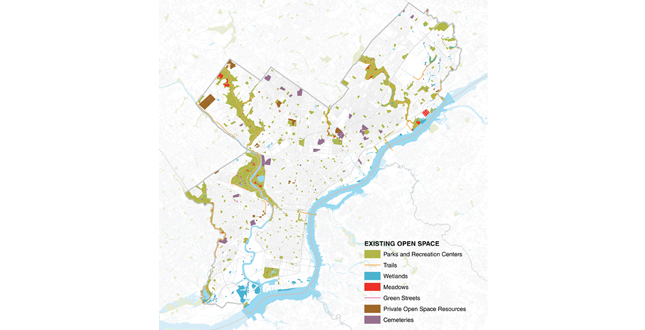 Close Me!
Close Me!A Unified Vision. GreenPlan Philadelphia is the City's first unified vision for the city’s parks, recreation spaces, and natural open spaces. It serves as an overall guide to open space in Philadelphia, rather than as a specific implementation plan.
Download Hi-Res ImageImage: Wallace Roberts & Todd (WRT)
Image 1 of 14
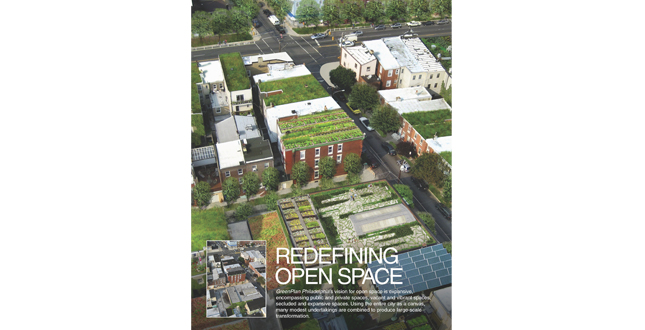 Close Me!
Close Me!Redefining Open Space. GreenPlan Philadelphia's vision for open space is expansive, encompassing public and private spaces, vacant and vibrant spaces, secluded and expansive spaces. Using the entire city as a canvas, many modest undertakings are combined to produce large-scale transformation.
Download Hi-Res ImageImage: Wallace Roberts & Todd (WRT)
Image 2 of 14
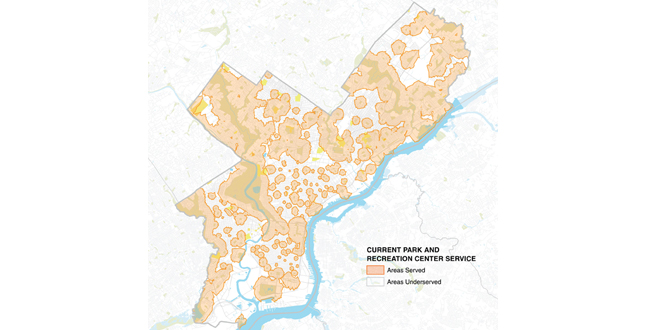 Close Me!
Close Me!Assessing Park and Recreation Access. More than 90% of Philadelphians live within a half mile of a park or recreation facility. However, when taking facility size and barriers to access into account, only 58% of residents are adequately served.
Download Hi-Res ImageImage: Wallace Roberts & Todd (WRT)
Image 3 of 14
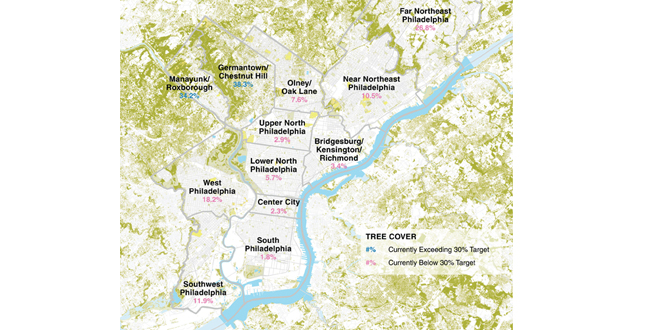 Close Me!
Close Me!Achieving 30% Tree Cover. GreenPlan Philadelphia sets a target to rebalance the inequitable distribution of tree cover and achieve 30% tree cover in every neighborhood. The green represents current tree cover.
Download Hi-Res ImageImage: Wallace Roberts & Todd (WRT)
Image 4 of 14
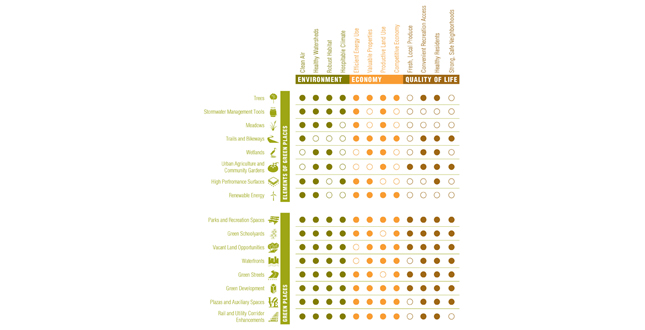 Close Me!
Close Me!Benefits Matrix. Environment, economy, and quality of life form the basis of GreenPlan Philadelphia's network of benefits, developed to clearly communicate goals, justify spending, objectively prioritize projects, and report progress. The innovative network issued as an organizational framework throughout.
Download Hi-Res ImageImage: Wallace Roberts & Todd (WRT)
Image 5 of 14
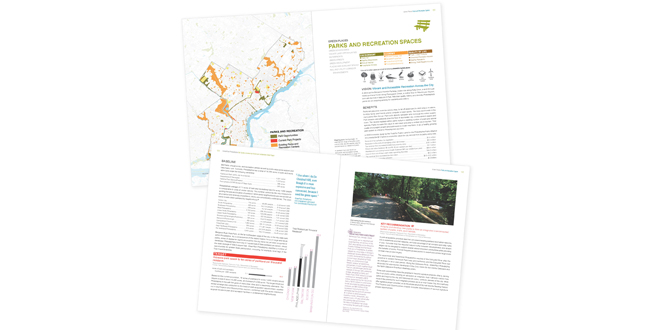 Close Me!
Close Me!Engaging, Content Rich Document. Pages from the parks and recreation spaces chapter show a sample: map of existing facilities, current projects, and opportunities; key to sustainability benefits and component elements; public quote; target and recommendation; indicator; benchmark; and best practice.
Download Hi-Res ImageImage: Wallace Roberts & Todd (WRT)
Image 6 of 14
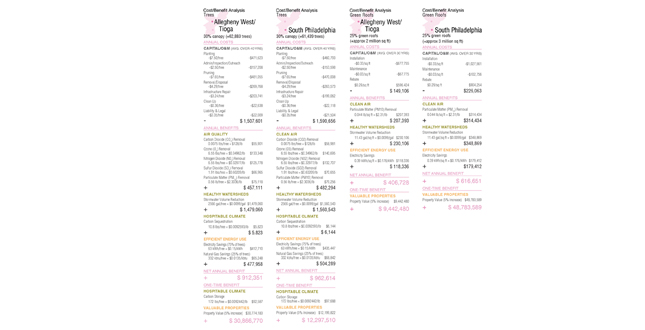 Close Me!
Close Me!Determining Cost Effectiveness. GreenPlan Philadelphia uses quantifiable costs and benefits of green elements to determine the potential return on investment in two representative square-mile areas. Rising energy and stormwater costs will surely increase the importance of implementation and returns.
Download Hi-Res ImageImage: Wallace Roberts & Todd (WRT)
Image 7 of 14
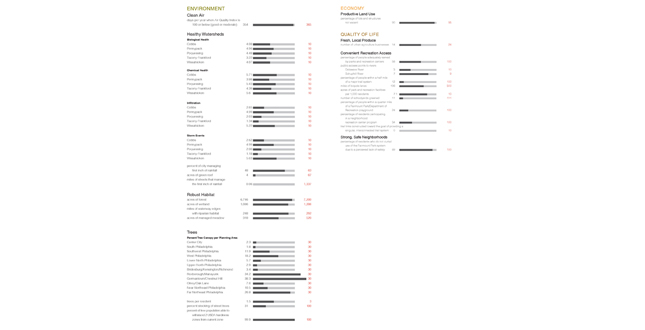 Close Me!
Close Me!Measuring Progress. The targets in each chapter form the benchmarks against which to measure progress. This chart provides baseline and target indicators that responsible agencies can measure with data that is currently available.
Download Hi-Res ImageImage: Wallace Roberts & Todd (WRT)
Image 8 of 14
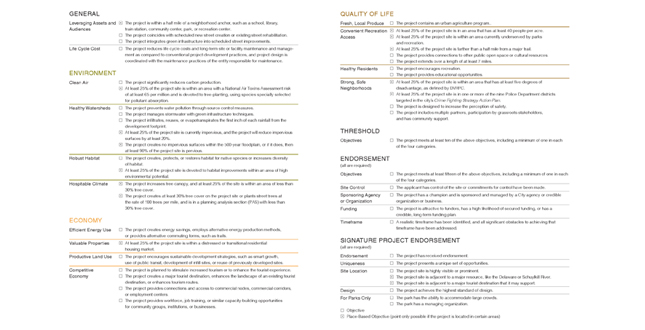 Close Me!
Close Me!Evaluating Opportunities. To ensure Philadelphians get the most for their open space dollars, GreenPlan Philadelphia includes an objective checklist for evaluating potential projects. Some criteria are place-based, recognizing neighborhoods have varying needs. The more objectives met, the more benefits provided.
Download Hi-Res ImageImage: Wallace Roberts & Todd (WRT)
Image 9 of 14
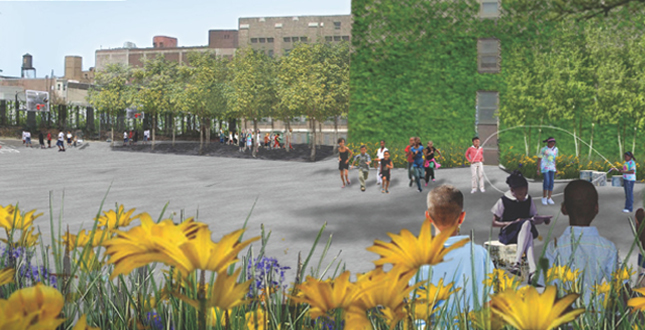 Close Me!
Close Me!Greening Schoolyards. This illustration images the type of transformations possible to turn oppressive hardscaped schoolyards into functional and enjoyable green schoolyards.
Download Hi-Res ImageImage: Wallace Roberts & Todd (WRT)
Image 10 of 14
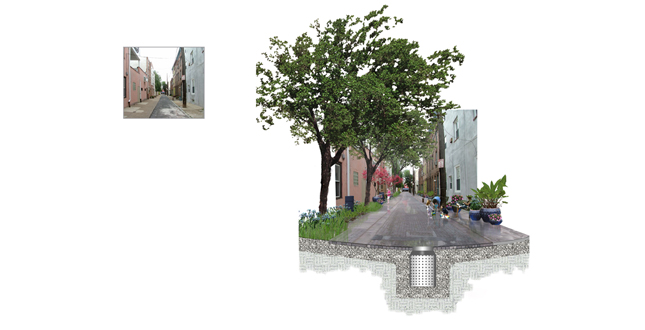 Close Me!
Close Me!Cooling and Draining a Small Street. Pavements and plantings along a narrow street can cool the street and improve its appearance while below-grade gravel layers and filtration channels infiltrate water into soils rather than conveying it to the sewer system.
Download Hi-Res ImageImage: Wallace Roberts & Todd (WRT)
Image 11 of 14
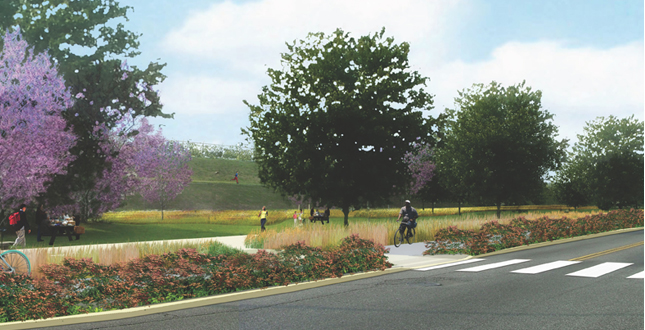 Close Me!
Close Me!Incorporating Meadows. Meadows can provide visual interest and access to naturalized plants, in relief to urban paving and lawns. Where open space is not actively programmed, allowing for a more natural landscape will yield significant maintenance and energy savings.
Download Hi-Res ImageImage: Wallace Roberts & Todd (WRT)
Image 12 of 14
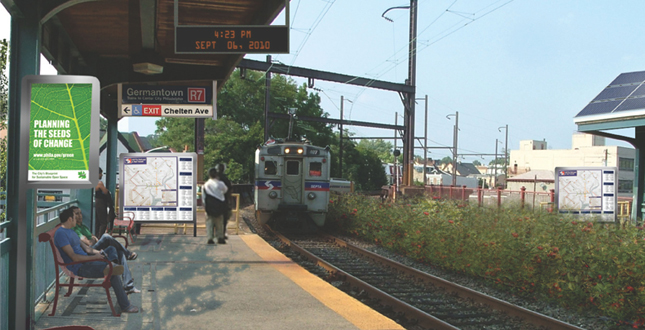 Close Me!
Close Me!Cleaning and Greening Rail Stations. Modest improvements can make drab train stations appealing and safer, including plantings along the tracks and around the station, new benches and information signs, ramps rather than stairs, and rooftop photovoltaic panels to supply power.
Download Hi-Res ImageImage: Wallace Roberts & Todd (WRT)
Image 13 of 14
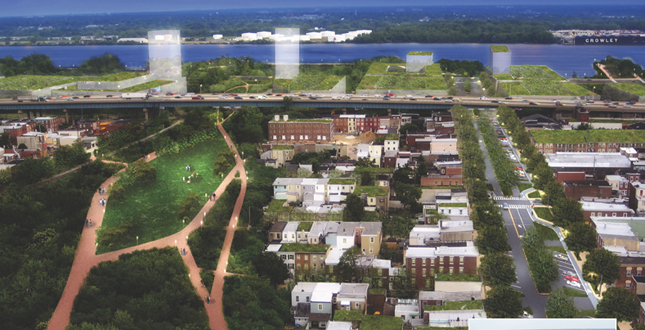 Close Me!
Close Me!Repurposing Underutilized Corridors. The train tracks adjacent to Lehigh Avenue occupy a fraction of this rail corridor. The test of the corridor could be used as park space with trails to connect residents to the Delaware River.
Download Hi-Res ImageImage: Wallace Roberts & Todd (WRT)
Image 14 of 14
Project Statement
GreenPlan Philadelphia takes an innovative approach to open space planning that goes well beyond that of a typical open space plan. Many open space plans focus on specific elements, such as parks or streets, or on specific issues, such as recreation or circulation. Rather than emphasize one set of networks or issues, GreenPlan Philadelphia integrates a range of environmental, economic, and social factors to make the case for and maximize the benefits of City efforts.
Project Narrative
—2011 Professional Awards Jury
The City of Philadelphia recognizes that the enhancement of its open space is critical to the city’s future. Thirteen City agencies collaborated with a team of consultants to develop GreenPlan Philadelphia, the city’s guide to achieving vibrant and sustainable urban places. The Plan will contribute to meeting the city’s contemporary challenges in a wide variety of ways and has already served as a major resource for other City plans: Greenworks Philadelphia (sustainability), Green2015 (park implementation), Philadelphia 2035 (comprehensive plan), and Green City, Clean Waters (stormwater management). The Plan reflects the input of thousands of Philadelphians who participated in a range of civic forums.
Green Elements and Places
The physical foundation of GreenPlan Philadelphia is made up of Green Elements and Places. Green Places are made up of elements that are the buildings blocks of the spaces that surround us outside.
Elements of Green Places include trees, stormwater management tools, meadows, trails and bikeways, wetlands, urban agriculture and community gardens, high performance surfaces, and renewable energy. While elements of green places provide a multitude of benefits on their own, the largest set of benefits can be achieved when multiple elements are combined into green places.
Green Places include parks and recreation spaces, green schoolyards, vacant land opportunities, waterfronts, green streets, green development, plazas and auxiliary spaces, and rail and utility corridor enhancements.
Targets and Recommendations
GreenPlan Philadelphia sets over 30 ambitious but attainable targets, with supporting recommendations for incorporating open space planning into the agenda for both private development and public works using the elements and places as an organizational framework. Targets include achieving at least 30% tree cover in every neighborhood; increasing park space to ten acres of parkland per thousand residents; greening 100 additional schoolyards through the Campus Parks program; creating a citywide network for 1,400 miles of green streets; and ensuring that there is a trail within a half mile of all residents.
Opportunities
In order to reach the plan’s targets and recommendations, Philadelphia will need to grow its open space network. GreenPlan Philadelphia identifies and maps a large number of opportunities to help achieve this.
Funding, Management and Operations, and Maintenance
GreenPlan Philadelphia also sets broad targets and select recommendations for funding, management, operations, and maintenance of open space. These recommendations are for both immediate use and consideration in the development of subsequent plans that focus in more detail on areas of concern.
Network of Benefits
The triad of environment, economy, and quality of life is the basis of GreenPlan Philadelphia’s network of benefits, developed specifically for Philadelphia to establish a common language for sustainable open space and to measure the City’s progress toward achieving a greener, more sustainable Philadelphia.
By including this network of benefits, GreenPlan Philadelphia provides the City a framework to clearly communicate goals, justify open space spending, objectively evaluate and prioritize open space projects, and report progress.
Environment
Trees and other vegetation trap carbon dioxide—a major cause of climate change—and airborne particulates, which ensures clean air. Wetlands intercept and manage stormwater from rain events, which reduces the burden on the sewer system, reduces runoff, recharges groundwater, and produces healthy watersheds. At the same time, trees, meadows, and wetlands provide robust habitat that serves as home for a variety of terrestrial, arboreal, aquatic, and avian species. Trees especially help ensure a hospitable climate by shading buildings and people in warm weather and breaking the wind in cold weather.
Economy
By shading buildings and breaking the wind, green infrastructure can help reduce electricity demand and promote efficient energy use. Local research has shown that proximity to trees and well-maintained open spaces can positively influence housing prices, creating more valuable properties. GreenPlan Philadelphia also recognizes that the city has quite a bit of vacant land, which presents an opportunity to become a more productive land use if used as temporary or permanent open spaces, or if redeveloped. By enhancing its open space network, which provides recreational amenities and leads to more valuable properties, Philadelphia can cultivate a competitive economy and become a city of choice for attracting businesses, residents, and events.
Quality of Life
Urban agriculture and community gardens make fresh, local produce available, offering an alternative to processed and fast foods. Parks, recreation centers, and trails that are appropriately sized and within walking distance provide convenient recreation access. The availability of places to recreate and exercise and the availability of fresh produce can make sure Philadelphia has healthy residents. Parks, recreation centers, schoolyards, and community gardens that are in good repair all help foster a sense of community, which leads to strong, safe neighborhoods.
Indicators
The network of benefits provides a framework to track and clearly communicate progress in achieving targets and recommendations. All indicators were selected based on available, measurable data to ensure progress can be tracked. Sample indicators include: for robust habitat, tracking acres of managed meadow from the current 318 acres to the target of 520 acres; for productive land use, tracking percentage of lots and structures not vacant from the current 90% to the target of 95%; and for fresh, local produce, tracking the number of urban agriculture businesses from the current 14 businesses to the target of 24 businesses.
Project Objectives
Also tied to the network of benefits is a set of objectives that help the City receive the most benefits from its investments. These objectives are organized into a checklist that encourages a strategic and transparent decision-making process in selecting the appropriate opportunities for investment. Sample objectives include determining if: for healthy watersheds, the project improves water quality through managing stormwater with green infrastructure techniques; for competitive economy, the project creates a major tourist destination, enhances the landscape of an existing tourist destination, or enhances tourism routes; and for convenient recreation access, at least 25% of the project site is within an area currently underserved by parks and recreation.
Project Resources
The Honorable Michael A. Nutter, Mayor
Management Group
Fairmount Park
Office of the Managing Director
Department of Commerce
Mayor’s Office of Sustainability
Philadelphia City Planning Commission
Philadelphia Water Department
Department of Recreation
Zoning Code Commission
Consultants
Wallace Roberts & Todd, LLC, Lead Consultant
Center for City Park Excellence, Trust for Public Land
Evergreen Capital Advisors, Inc.
SK Designworks, Inc.
Nitsch Engineering
James S. Russell, AIA
The Pennsylvania Horticultural Society
Western Pennsylvania Conservancy
City of Philadelphia
Department of Public Property
Department of Commerce
Department of Public Health
Department of Streets
Fairmount Park
Law Department
Office of the Managing Director
Mayor’s Office of Sustainability
Division of Technology
Office of Housing and Community Development
Office of the Mayor
Philadelphia City Planning Commission
Philadelphia Historical Commission
Philadelphia Police Department
Department of Recreation
Philadelphia Water Department
Philadelphia Housing Authority
Philadelphia Redevelopment Authority
Funders
City of Philadelphia
Pennsylvania Department of Conservation and Natural Resources
William Penn Foundation
United States Forest Service
PECO, An Exelon Company
Partners
City Parks Association
Delaware Valley Regional Planning Commission
EPA Region III
Keystone Conservation Trust
Pennsylvania Department of Conservation and Natural Resources
Pennsylvania Environmental Council
Philadelphia Association of Community Development Corporations
The School District of Philadelphia
The Pennsylvania Horticultural Society
United States Fish and Wildlife Service
United States Forest Service
Other Plan Participants
Awbury Arboretum
Center City District
Delaware River City Corporation
Delaware Valley Green Building Council
Fairmount Park Art Association
Farm to City
Impact Services Corporation
Mill Creek Farm
The National Archives
National Park Service
Neighborhood Gardens Association
New Kensington Community Development Corporation
Philadelphia Orchard Project
Penn State University, School of Forest Resources
PennPraxis
Delaware River Waterfront Corporation
Pennsylvania Department of Transportation
Pennsylvania Economy League
Philadelphia Industrial Development Corporation
Philadelphia Parks Alliance
Philadelphia Zoo
Project N.E.A.T.
Schuylkill Center for Environmental Education
Schuylkill River Development Corporation
Sierra Club
University of Pennsylvania, Leonard Davis Institute, Robert Wood Johnson Health & Society Scholars Program






